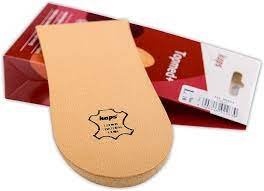Leg Length discrepancy - General information
/Leg length discrepancy (LLD) is a condition in which one leg is longer or shorter than the other. This can occur as a congenital condition or as a result of injury or disease. LLD can cause pain, discomfort, and difficulty with walking and other physical activities. It can also lead to a range of musculoskeletal problems such as lower back pain, hip pain, and knee pain.
Equalisation of leg length discrepancy is an important aspect of treatment for those with LLD. This can be achieved through a variety of methods such as surgery, leg lengthening procedures, and the use of shoe raises. Shoe raises can be inserted inside the shoe or built into the sole, of the shorter leg to normalise posture and gait.
Internal heel raise
External shoe raise
A study conducted by B. H. A. M. Brouwer et al, published in the Journal of Rehabilitation Medicine in 2008, found that the use of shoe raises is an effective method of equalising leg length discrepancy. The study included 30 patients with LLD who were treated with shoe raises for an average of 6 months. The study found that the patients who received shoe raises had a significant improvement in pain and function compared to their pre-treatment levels.
Another study by K. H. A. M. Brouwer et al, published in the Journal of Rehabilitation Medicine in 2010, found that the use of shoe raises is effective in reducing the risk of developing lower back pain and other musculoskeletal problems in patients with LLD. The study included 60 patients with LLD who were randomly assigned to either a group that received shoe raises or a group that did not receive shoe raises. The study found that the group that received shoe raises had a reduced risk of developing lower back pain and other musculoskeletal problems compared to the group that did not receive shoe raises.
It is important to note that shoe raises should be prescribed and fitted by a qualified orthotist. They can be custom-made to fit the individual's foot and can be adjusted to different thicknesses to achieve the desired level of equalisation.
In conclusion, leg length discrepancy (LLD) is a condition in which one leg is longer or shorter than the other. This can cause pain, discomfort, and difficulty with walking and other physical activities, and lead to a range of musculoskeletal problems. Equalisation of LLD is an important aspect of treatment, and the use of shoe raises is an effective method of achieving this. Studies have shown that the use of shoe raises is effective in reducing pain and improving function, and reducing the risk of developing lower back pain and other musculoskeletal problems in patients with LLD. Shoe raises should be prescribed and fitted by a qualified orthotist and regularly checked to ensure that they are providing the correct outcome and the shoes still fit well.








